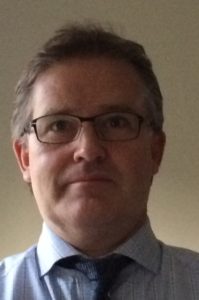
 Elena Moro (EM): As incoming co-chair of the Scientific Panel “Muscle and NMJ disorders” can you briefly introduce yourself and your specific field of expertise to the EANpages readers.
Elena Moro (EM): As incoming co-chair of the Scientific Panel “Muscle and NMJ disorders” can you briefly introduce yourself and your specific field of expertise to the EANpages readers.
Benedikt Schoser has more than 20 years’ experience as a neurologist and myopathologist in a variety of areas of neuromuscular disorders, including myopathological, structural, biochemical and molecular genetic muscle research, and clinical trials. Major focus of his research activities are the genetic-pathomorphological base of neuromuscular disorders, like limb girdle muscular dystrophies and especially myotonic dystrophies. To establish the analysis of pathogenesis, he collected multiple tissue samples including human myoblasts and DNA, of patients during the past 15 years. After medical school at the University of Mainz, Germany from 1985-1993, he finished his medical thesis (Dr. med.) at the Department of Neuropathology, University of Mainz in 1993. He was a resident and faculty member in Neurology and Psychiatry at the University Clinics of Mainz, Frankfurt and Hamburg, Germany. In 2000 he joined Professor Thomas Jentsch for his postdoctoral fellowship at the Department of Neuropathophysiology, Zentrum für Molekulare Neurobiology Hamburg, Germany. In 2001 he moved to the Friedrich-Baur-Institute at the Department of Neurology, Ludwig-Maximilians-University of Munich. He was board certificated in Neurology in 2000 and as Intensive Care Neurologist in 2001. In 2005 he got the board certification as a neurophysiologist. Since 2004 he is senior consultant neurologist and finished his faculty rank (habilitation) in Neurology in the same year. In 2006 he was visiting professor at the Baylor College in Houston, USA. Since 2010 he is associated Professor of Neurology and head of the Interdisciplinary Center for Neuromuscular Disorders, LMU Munich. He has served on numerous peer review committees of the Italian Telethon, French AFM, and British MDC reviewing international grant applications in neuromuscular disorders. He is ad hoc-reviewer for several international journals, incl. Brain, Annals of Neurology, Neurology, Journal of Neurology, American Journal of Human Genetics, European Journal of Human Genetics, Neuromuscular disorders, and is has co-authored more than 160 peer-reviewed publications in clinical and translational science. Since 2003 he is member of the German network of muscular dystrophies (MD-Net). In 2009 he organized the international myotonic dystrophy consortium in Würzburg, Germany, and in 2013 the international glycogen storage disease conference in Heidelberg. Since March 2015 he is the first elected chair of the new funded European Pompe Consortium EPOC.
Antonio Toscano is Professor of Neurology, since 2009, at the Department of Clinical and Experimental Medicine of the University of Messina, Italy. He is responsible of a Clinical, Biochemical and Genetic Unit for patients with rare Neuromuscular Disorders. He received his MD “cum laude” in 1981 and specialized in Neurology in 1985 at the University of Messina. From 1986 to 1987, he attended as a fellow “The National Hospital for Nervous Diseases”, London, UK, under the guide of dr. John Morgan-Hughes, studying Mitochondrial Disorders. His main research interests are focused on Neuromuscular and Neurodegenerative Disorders with particular attention to metabolic myopathies and, more specifically, to pathogenic, clinical and therapeutic aspects of muscle glycogenoses (i.e Pompe disease), lipid storage, mitochondrial myopathies and other rare neurodegenerative disorders. In these fields, he has published over 160 papers.
He is also Past President of the Italian Association of Myology (AIM), Member of the Scientific Committee of the European Academy of Neurology (EAN), Member of the EPOC (European Pompe Consortium) and Co-Chairman of the EAN Panel for Muscle and Neuromuscular Junction Disorders, apart from other memberships of several other National and International Scientific Societies and Groups
EM: Can you outline the strategic work plan you foresee for the Scientific Panel that you co-chair?
BS+AT: We can summarize our strategy under the umbrella of: “Let´s join forces to show what we already have!” In other words, give to this new network a proper identity as a group
So far, neuromuscular specialists have been underrepresented in the context of EAN.
We would like to increase the number of specialists participating to Panel activities, also including people coming from countries where this subspecialty has been less attended.
It is important to inform about the new bunch of knowledge we have gained in the field during the past 20 years and exchange experiences.
Recently, over 800 different neuromuscular disorders have been deciphered and some of us have contributed to this work. Consequently, we have also started to treat patients, even considering their molecular background.
In addition, several clinical trials are ongoing and this knowledge has to be necessarily transmitted to all members of the EAN.
Hopefully, we are also looking forward to create a very strict link with Patients Associations to make them aware about diagnostic and therapeutic novelties and collaborate to support these common activities
EM: What is the main “deliverable” that you want to achieve for the work the Scientific Panel will address during your term of office?
BS+AT: With the EAN support, we would like to:
a) organize scientific symposia and practical sessions for attendees during the next meetings but even educational events spread during the year with particular reference to young neurologists in an attempt to expand knowledge and increase awareness of these muscle and neuromuscular junction disorders
b) propose guidelines and recommendations regarding different fields of those disorders
c) make the group ready for future projects regarding either modern diagnostic procedures or clinical trials on molecular therapy strategies for neuromuscular disorders. Overcome any neglect regarding therapy, as muscle and brain together moves our body.













